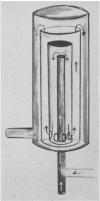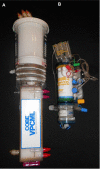Evolution of membrane oxygenator technology for utilization during pediatric cardiopulmonary bypass
- PMID: 29388637
- PMCID: PMC5683297
- DOI: 10.2147/PHMT.S35070
Evolution of membrane oxygenator technology for utilization during pediatric cardiopulmonary bypass
Abstract
The development of the membrane oxygenator for pediatric cardiopulmonary bypass has been an incorporation of ideology and technological advancements with contributions by many investigators throughout the past two centuries. With the pursuit of this technological achievement, the ability to care for mankind in the areas of cardiac surgery has been made possible. Heart disease can affect anyone within the general population, but one such segment that it can affect from inception includes children. Currently, congenital heart defects are the most common birth defects nationally and worldwide. A large meta-analysis study from 1930 to 2010 was conducted in review of published medical literature totaling 114 papers with a study population of 24,091,867 live births, and divulged a staggering incidence of congenital heart disease involving 164,396 subjects with diverse cardiac illnesses. The prevalence of these diseases increased from 0.6 per 1,000 live births from 1930-1934 to 9.1 per 1,000 live births after 1995. These data reveal an emphasis on a growing public health issue regarding congenital heart disease. This discovery displays a need for heightened awareness in the scientific and medical industrial community to accelerate investigative research on emerging cardiovascular devices in an effort to confront congenital anomalies. One such device that has evolved over the past several decades is the pediatric membrane oxygenator. The pediatric membrane oxygenator, in conjunction with the heart lung machine, assists in the repair of most congenital cardiac defects. Numerous children born with congenital heart disease with or without congestive heart failure have experienced improved clinical outcomes in quality of life, survival, and mortality as a result of the inclusion of this technology during their cardiac surgical procedure. The purpose of this review is to report a summary of the published medical and scientific literature related to development of the pediatric membrane oxygenator from its conceptual evolutionary stages to artificially supporting whole body perfusion in the modern pediatric cardiac surgical setting.
Keywords: cardiovascular perfusion; extracorporeal technological advancement; pediatric cardiac surgery.
Conflict of interest statement
Disclosure The authors of this manuscript did not receive any funding or preferential treatment from any manufacturing group. The information used for this project was voluntarily provided. The authors report no conflicts of interest in this work.
Figures







Similar articles
-
Extracorporeal Membrane Oxygenation in Congenital Heart Disease.Children (Basel). 2022 Mar 9;9(3):380. doi: 10.3390/children9030380. Children (Basel). 2022. PMID: 35327752 Free PMC article. Review.
-
Extracorporeal Membrane Oxygenation Support for Failure to Wean From Cardiopulmonary Bypass After Pediatric Cardiac Surgery: Analysis of Extracorporeal Life Support Organization Registry Data.Crit Care Explor. 2020 Sep 15;2(9):e0183. doi: 10.1097/CCE.0000000000000183. eCollection 2020 Sep. Crit Care Explor. 2020. PMID: 32984825 Free PMC article.
-
The future of Cochrane Neonatal.Early Hum Dev. 2020 Nov;150:105191. doi: 10.1016/j.earlhumdev.2020.105191. Epub 2020 Sep 12. Early Hum Dev. 2020. PMID: 33036834
-
Extracorporeal lung support technologies - bridge to recovery and bridge to lung transplantation in adult patients: an evidence-based analysis.Ont Health Technol Assess Ser. 2010;10(5):1-47. Epub 2010 Apr 1. Ont Health Technol Assess Ser. 2010. PMID: 23074408 Free PMC article.
-
Origins and Evolution of Extracorporeal Circulation: JACC Historical Breakthroughs in Perspective.J Am Coll Cardiol. 2022 Apr 26;79(16):1606-1622. doi: 10.1016/j.jacc.2022.02.027. J Am Coll Cardiol. 2022. PMID: 35450579 Review.
Cited by
-
Sorption/Diffusion Contributions to the Gas Permeation Properties of Bi-Soft Segment Polyurethane/Polycaprolactone Membranes for Membrane Blood Oxygenators.Membranes (Basel). 2020 Jan 2;10(1):8. doi: 10.3390/membranes10010008. Membranes (Basel). 2020. PMID: 31906453 Free PMC article.
-
Kappa opioid receptor agonists improve postoperative cognitive dysfunction in rats via the JAK2/STAT3 signaling pathway.Int J Mol Med. 2019 Nov;44(5):1866-1876. doi: 10.3892/ijmm.2019.4339. Epub 2019 Sep 13. Int J Mol Med. 2019. PMID: 31545485 Free PMC article.
-
Drug Disposition and Pharmacotherapy in Neonatal ECMO: From Fragmented Data to Integrated Knowledge.Front Pediatr. 2019 Sep 3;7:360. doi: 10.3389/fped.2019.00360. eCollection 2019. Front Pediatr. 2019. PMID: 31552205 Free PMC article. Review.
References
-
- Hooke R. An account of an experiment made by M. Hook, of preserving animals alive by blowing through their lungs with a bellows. Philos Trans R Soc Lond. 1667;2:539–540.
-
- Le Gallois M. Experiments on the principle of life: and particularly on the principle of the motions of the heart, and on the seat of this principle: including the report made to the first class of the Institute upon the experiments relative to the motions of the heart. Philadelphia, PA: M Thomas; 1813.
-
- Hoffman JI, Kaplan S. The incidence of congenital heart disease. J Am Coll Cardiol. 2002;39:1890–1900. - PubMed
-
- van der Linde D, Konings EE, Slager MA, et al. Birth prevalence of congenital heart disease worldwide a systematic review and meta-analysis. J Am Coll Cardiol. 2011;58:2241–2247. - PubMed
-
- Prevost JL, Dumas JB. Examen du sang et de son action dans les divers phe´nome´nes de la vie. Annales de Chimie. 1821;18:280–296. French.
Publication types
LinkOut - more resources
Full Text Sources
Other Literature Sources
Miscellaneous

